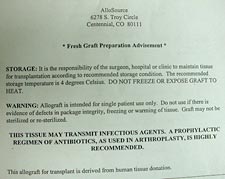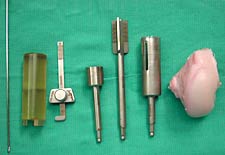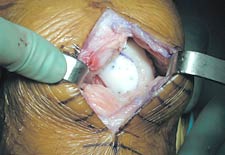Be keenly aware of clinical risks related to using fresh allografts
Immunoresponse is a concern; one center reported a 90% failure rate with allograft procedures involving patients who were antibody-positive.
|
Using allograft tissue in orthopedic procedures requires the utmost regard for safety and professional responsibility. In addition to dealing with patients who sometimes have unreasonable expectations regarding their outcomes with fresh allografts, there are several clinical issues that physicians need to be aware of before attempting these kinds of procedures.
“Know the clinical issues. They’re very different from the other treatments that you [do],” said William D. Bugbee, MD, assistant professor in the department of orthopedics at the University of California–San Diego (UCSD).
For example, fresh allografts do not undergo typical sterilization procedures at a tissue bank but are simply tested for viral and bacterial contamination before shipping. Therefore, shoddy testing methods could increase the risk that an allograft is contaminated.
Use reputable tissue banks
Bugbee, a member of the medical advisory board for Allosource, a tissue bank accredited by the American Association of Tissue Banks (AATB) in McLean, Va., recommended obtaining musculoskeletal allografts only from AATB-accredited organizations. “Just use a reputable tissue bank. That’s the best you can do,” he said.
|
Would-be users of allografts should also fully understand how tissue banks operate. If an infection or other type of disease transmission occurs, it is ultimately the physician’s responsibility.
“When in doubt, call the medical director of the tissue bank that’s sending you the tissue and talk to them about the donor. Then you’ve covered all your bases,” he said.
At a more practical level, it helps to lavage the allograft tissue prior to implantation. “That’s a safety issue,” Bugbee said. “Plus, it removes the marrow elements that may be important in the immune response to the osseous portion of the graft, which is not processed or frozen.”
Safety regulations increasing
The risk of disease transmission for fresh allografts is still relatively low despite the cases of musculoskeletal allograft contamination reported in recent years by the Food and Drug Administration and the Centers for Disease Control and Prevention.
|
“It’s historically a remarkably unregulated industry, although this will change with new federal regulations,” Bugbee said. “There are currently more regulations that go into your toaster than into the tissue you use in surgery, believe it or not.”
Federal regulations are now being instituted to improve donor screening and regulate tissue collection, storage, record keeping and other safe tissue practices.
“On that basis, allograft tissue is very safe,” said Bugbee, who added that there have been no cases of viral or bacterial transmission in the more than 400 allograft procedures performed at UCSD. He and his colleagues attribute this, in part, to the close attention paid to these key clinical concerns and the tissue bank they use.
Still, with these kinds of procedures, the physician nearly always has some liability risk.
“My liability with doing a total knee or a revision arthroplasty is far greater than my liability doing a fresh, let alone a processed allograft. But in many tissue banks that are doing this, it’s a new enterprise. So ultimately, remember that you’re responsible,” Bugbee said.
“Nevertheless, a rational analysis leads to the conclusion that fresh allografts are tremendously useful in orthopedic surgery.”
Immunoresponse to fresh allograft is yet another concern, he added, although based on retrieval studies, researchers have yet to report any incidents of cell mediated graft rejection.
“Fifty percent of our patients have human leukocyte antigen (HLA) cytotoxic antibodies. They are associated with inferior appearance on MR. Ninety percent of our failures are HLA antibody positive.”
He said doctors should discuss the risks of allograft tissue with female patients of childbearing age who have anti-HLA antibodies, although this has not been a clinical issue in his own cases.
|



